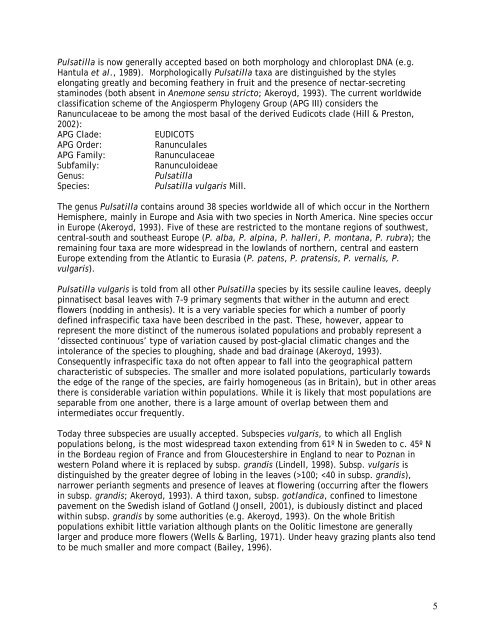Pulsatilla vulgaris (L.) Mill. - Plantlife
Pulsatilla vulgaris (L.) Mill. - Plantlife
Pulsatilla vulgaris (L.) Mill. - Plantlife
Create successful ePaper yourself
Turn your PDF publications into a flip-book with our unique Google optimized e-Paper software.
<strong>Pulsatilla</strong> is now generally accepted based on both morphology and chloroplast DNA (e.g.<br />
Hantula et al., 1989). Morphologically <strong>Pulsatilla</strong> taxa are distinguished by the styles<br />
elongating greatly and becoming feathery in fruit and the presence of nectar-secreting<br />
staminodes (both absent in Anemone sensu stricto; Akeroyd, 1993). The current worldwide<br />
classification scheme of the Angiosperm Phylogeny Group (APG III) considers the<br />
Ranunculaceae to be among the most basal of the derived Eudicots clade (Hill & Preston,<br />
2002):<br />
APG Clade: EUDICOTS<br />
APG Order: Ranunculales<br />
APG Family: Ranunculaceae<br />
Subfamily: Ranunculoideae<br />
Genus: <strong>Pulsatilla</strong><br />
Species: <strong>Pulsatilla</strong> <strong>vulgaris</strong> <strong>Mill</strong>.<br />
The genus <strong>Pulsatilla</strong> contains around 38 species worldwide all of which occur in the Northern<br />
Hemisphere, mainly in Europe and Asia with two species in North America. Nine species occur<br />
in Europe (Akeroyd, 1993). Five of these are restricted to the montane regions of southwest,<br />
central-south and southeast Europe (P. alba, P. alpina, P. halleri, P. montana, P. rubra); the<br />
remaining four taxa are more widespread in the lowlands of northern, central and eastern<br />
Europe extending from the Atlantic to Eurasia (P. patens, P. pratensis, P. vernalis, P.<br />
<strong>vulgaris</strong>).<br />
<strong>Pulsatilla</strong> <strong>vulgaris</strong> is told from all other <strong>Pulsatilla</strong> species by its sessile cauline leaves, deeply<br />
pinnatisect basal leaves with 7-9 primary segments that wither in the autumn and erect<br />
flowers (nodding in anthesis). It is a very variable species for which a number of poorly<br />
defined infraspecific taxa have been described in the past. These, however, appear to<br />
represent the more distinct of the numerous isolated populations and probably represent a<br />
‘dissected continuous’ type of variation caused by post-glacial climatic changes and the<br />
intolerance of the species to ploughing, shade and bad drainage (Akeroyd, 1993).<br />
Consequently infraspecific taxa do not often appear to fall into the geographical pattern<br />
characteristic of subspecies. The smaller and more isolated populations, particularly towards<br />
the edge of the range of the species, are fairly homogeneous (as in Britain), but in other areas<br />
there is considerable variation within populations. While it is likely that most populations are<br />
separable from one another, there is a large amount of overlap between them and<br />
intermediates occur frequently.<br />
Today three subspecies are usually accepted. Subspecies <strong>vulgaris</strong>, to which all English<br />
populations belong, is the most widespread taxon extending from 61º N in Sweden to c. 45º N<br />
in the Bordeau region of France and from Gloucestershire in England to near to Poznan in<br />
western Poland where it is replaced by subsp. grandis (Lindell, 1998). Subsp. <strong>vulgaris</strong> is<br />
distinguished by the greater degree of lobing in the leaves (>100;

















